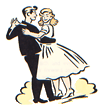 |
ROUND DANCING — CHOREOGRAPHED BALLROOMEDUCATIONAL ARTICLESMAJOR SECTIONS: Figures | Articles | Links | Alph. Index | Search | Home |
|
|
Behold, the Box!by Roy & Phyllis Stier The box is probably the most basic of round dance figures because it is used so extensively in the easy and intermediate levels, with the variations that go with it. In early ballroom, it was called a "square" because the footwork described that configuration on the dance floor. Since the word "box" seems to be the most succinct and self-explanatory, it persisted and became standardized. SIDE, CLOSE, FORWARD, -; SIDE, CLOSE, BACK, -; — the full [two step] box is a standard basic in two step and Cuban rumba. It could be used this way in quickstep and fox trot; however, it is not generally found, particularly in the former. In International rumba, the box has not been employed as such but has been substituted by the basic FORWARD, RECOVER, SIDE, -; BACK, RECOVER, SIDE, -; Other rhythms use variations of the box, particularly as a 1/2 box or in turning movements. Pure tango, samba, cha cha, merengue, mambo, jive or swing, bolero (slow rumba), paso doble, schottische, and polka seem to be immune from the box, even the variations; however, it is always possible to use any figure that fits the music in our round dance choreography — there are no hard and fast rules.We are all familiar with the waltz box (FWD, SD, CL; BK, SD, CL;). In standard fox trot, either American or slow, we also use the same movement as in the waltz (S,Q,Q; timing). The problem of what to call this still persists and has not been standardized, although many people have definite convictions as to what is correct. "Fox trot box" is self explanatory but too long for normal cueing. Some folks use "foxie box," taken from a contraction of fox trot or from the dance Foxie, whichever seems appropriate. Others hold to the term "waltz box" when used in a fox trot or two step rhythm. Others take for granted that if the dancers are doing a fox trot, the simple cue "box" is all that is needed to get the idea across. In different parts of the country, colloquial expressions are used such as "Westchester box" or "sugar foot box." All of this tends to muddy up the waters and makes it difficult to agree on a universal term. Perhaps we need a summit conference. The turning box is a standard for basic waltz and fox trot and usually is done in 1/4 increments. If we increase this to 3/8 and give it some sway, we have the International turn in waltz. By utilizing the progressive box with a turn on steps 2 & 3, we have the twinkle — and so it goes. … Let us not disdain the lowly box but recognize that our heritage is wrapped up in its many permutations.
This column comes from a series published in Cue Sheet Magazine between 1987 and 1992, and is reprinted with permission. The full series is collected in an 86-pg booklet, available for $30.00 plus postage. E-mail Fran Kropf at cutecuer@cox.net. This article was published in the Dixie Round Dance Council (DRDC) Newsletter, November 2008.
|
 |
|
|
Page last revised